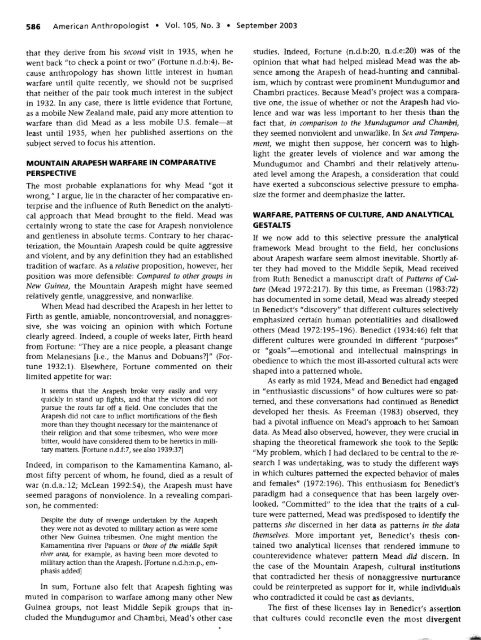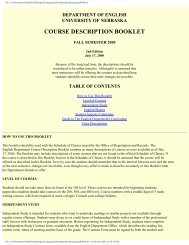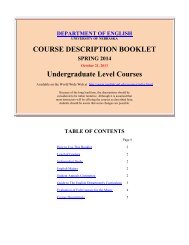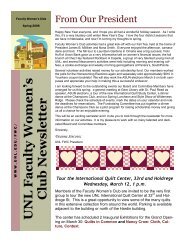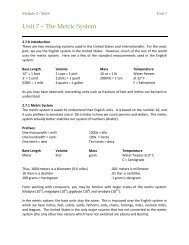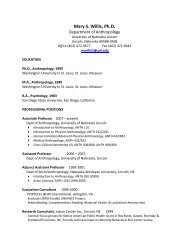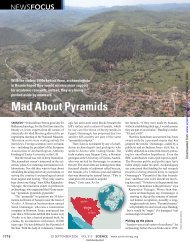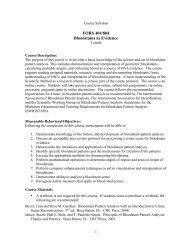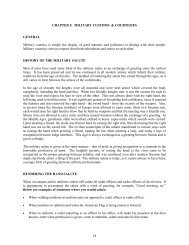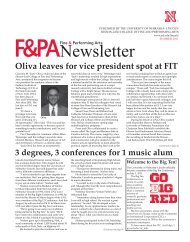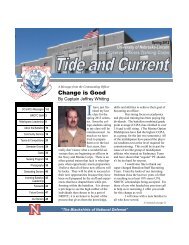Margaret Mead, Reo Fortune, and Mountain Arapesh Warfare
Margaret Mead, Reo Fortune, and Mountain Arapesh Warfare
Margaret Mead, Reo Fortune, and Mountain Arapesh Warfare
You also want an ePaper? Increase the reach of your titles
YUMPU automatically turns print PDFs into web optimized ePapers that Google loves.
586 American Anthropologist • Vol. 105, No. 3 • September 2003<br />
that they derive from his second visit in 1935, when he<br />
went back "to check a point or two" (<strong>Fortune</strong> n.d.b:4). Because<br />
anthropology has shown little interest in human<br />
warfare until quite recently, we should not be surprised<br />
that neither of the pair took much interest in the subject<br />
in 1932. In any case, there is little evidence that <strong>Fortune</strong>,<br />
as a mobile New Zeal<strong>and</strong> male, paid any more attention to<br />
warfare than did <strong>Mead</strong> as a less mobile U.S. female—at<br />
least until 1935, when her published assertions on the<br />
subject served to focus his attention.<br />
MOUNTAIN ARAPESH WARFARE IN COMPARATIVE<br />
PERSPECTIVE<br />
The most probable explanations for why <strong>Mead</strong> "got it<br />
wrong," I argue, lie in the character of her comparative enterprise<br />
<strong>and</strong> the influence of Ruth Benedict on the analytical<br />
approach that <strong>Mead</strong> brought to the field. <strong>Mead</strong> was<br />
certainly wrong to state the case for <strong>Arapesh</strong> nonviolence<br />
<strong>and</strong> gentleness in absolute terms. Contrary to her characterization,<br />
the <strong>Mountain</strong> <strong>Arapesh</strong> could be quite aggressive<br />
<strong>and</strong> violent, <strong>and</strong> by any definition they had an established<br />
tradition of warfare. As a relative proposition, however, her<br />
position was more defensible: Compared to other groups in<br />
New Guinea, the <strong>Mountain</strong> <strong>Arapesh</strong> might have seemed<br />
relatively gentle, unaggressive, <strong>and</strong> nonwarlike.<br />
When <strong>Mead</strong> had described the <strong>Arapesh</strong> in her letter to<br />
Firth as gentle, amiable, noncontroversial, <strong>and</strong> nonaggressive,<br />
she was voicing an opinion with which <strong>Fortune</strong><br />
clearly agreed. Indeed, a couple of weeks later, Firth heard<br />
from <strong>Fortune</strong>: "They are a nice people, a pleasant change<br />
from Melanesians [i.e., the Manus <strong>and</strong> Dobuans?]" (<strong>Fortune</strong><br />
1932; 1). Elsewhere, <strong>Fortune</strong> commented on their<br />
limited appetite for war:<br />
It seems that the <strong>Arapesh</strong> broke very easily <strong>and</strong> very<br />
quickly in st<strong>and</strong> up fights, <strong>and</strong> that the victors did not<br />
pursue the routs far off a field. One concludes that the<br />
<strong>Arapesh</strong> did not care to inflict mortifications of the flesh<br />
more than they thought necessary for the maintenance of<br />
their religion <strong>and</strong> that some tribesmen, who were more<br />
bitter, would have considered them to be heretics in military<br />
matters. [<strong>Fortune</strong> n.d.f:7, see also 1939:37]<br />
Indeed, in comparison to the Kamamentina Kamano, almost<br />
fifty percent of whom, he found, died as a result of<br />
war (n.d.a.:12; McLean 1992:54), the <strong>Arapesh</strong> must have<br />
seemed paragons of nonviolence. In a revealing comparison,<br />
he commented:<br />
Despite the duty of revenge undertaken by the <strong>Arapesh</strong><br />
they were not as devoted to military action as were some<br />
other New Guinea tribesmen. One might mention the<br />
Kamamentina river Papuans or those of the middle Sepik<br />
river area, for example, as having been more devoted to<br />
military action than the <strong>Arapesh</strong>. [<strong>Fortune</strong> n.d.h:n.p., emphasis<br />
added]<br />
In sum, <strong>Fortune</strong> also felt that <strong>Arapesh</strong> fighting was<br />
muted in comparison to warfare among many other New<br />
Guinea groups, not least Middle Sepik groups that included<br />
the Mundugumor <strong>and</strong> Chambri, <strong>Mead</strong>'s other case<br />
studies. Indeed, <strong>Fortune</strong> (n.d,b:20, n,d.e:20) was of the<br />
opinion that what had helped mislead <strong>Mead</strong> was the absence<br />
among the <strong>Arapesh</strong> of head-hunting <strong>and</strong> cannibalism,<br />
which by contrast were prominent Mundugumor <strong>and</strong><br />
Chambri practices. Because <strong>Mead</strong>'s project was a comparative<br />
one, the issue of whether or not the <strong>Arapesh</strong> had violence<br />
<strong>and</strong> war was less important to her thesis than the<br />
fact that, in comparison to the Mundugumor <strong>and</strong> Chambri,<br />
they seemed nonviolent <strong>and</strong> unwarlike. In Sex <strong>and</strong> Temperament,<br />
we might then suppose, her concern was to highlight<br />
the greater levels of violence <strong>and</strong> war among the<br />
Mundugumor <strong>and</strong> Chambri <strong>and</strong> their relatively attenuated<br />
level among the <strong>Arapesh</strong>, a consideration that could<br />
have exerted a subconscious selective pressure to emphasize<br />
the former <strong>and</strong> deemphasize the latter.<br />
WARFARE, PATTERNS OF CULTURE, AND ANALYTICAL<br />
GESTALTS<br />
If we now add to this selective pressure the analytical<br />
framework <strong>Mead</strong> brought to the field, her conclusions<br />
about <strong>Arapesh</strong> warfare seem almost inevitable, Shortly after<br />
they had moved to the Middle Sepik, <strong>Mead</strong> received<br />
from Ruth Benedict a manuscript draft of Patterns of Culture<br />
(<strong>Mead</strong> 1972:217). By this time, as Freeman (1983:72)<br />
has documented in some detail, <strong>Mead</strong> was already steeped<br />
in Benedict's "discovery" that different cultures selectively<br />
emphasized certain human potentialities <strong>and</strong> disallowed<br />
others (<strong>Mead</strong> 1972:195-196). Benedict (1934:46) felt that<br />
different cultures were grounded in different "purposes"<br />
or "goals"—emotional <strong>and</strong> intellectual mainsprings in<br />
obedience to which the most ill-assorted cultural acts were<br />
shaped into a patterned whole.<br />
As early as mid 1924, <strong>Mead</strong> <strong>and</strong> Benedict had engaged<br />
in "enthusiastic discussions" of how cultures were so patterned,<br />
<strong>and</strong> these conversations had continued as Benedict<br />
developed her thesis. As Freeman (1983) observed, they<br />
had a pivotal influence on <strong>Mead</strong>'s approach to her Samoan<br />
data. As <strong>Mead</strong> also observed, however, they were crucial in<br />
shaping the theoretical framework she took to the Sepik:<br />
"My problem, which I had declared to be central to the research<br />
I was undertaking, was to study the different ways<br />
in which cultures patterned the expected behavior of males<br />
<strong>and</strong> females" (1972:196). This enthusiasm for Benedict's<br />
paradigm had a consequence that has been largely overlooked.<br />
"Committed" to the idea that the traits of a culture<br />
were patterned, <strong>Mead</strong> was predisposed to identify the<br />
patterns she discerned in her data as patterns in the data<br />
themselves. More important yet, Benedict's thesis contained<br />
two analytical licenses that rendered immune to<br />
counterevidence whatever pattern <strong>Mead</strong> did discern. In<br />
the case of the <strong>Mountain</strong> <strong>Arapesh</strong>, cultural institutions<br />
that contradicted her thesis of nonaggressive nurturance<br />
could be reinterpreted as support for it, while individuals<br />
who contradicted it could be cast as deviants.<br />
The first of these licenses lay in Benedict's assertion<br />
that cultures could reconcile even the most divergent


